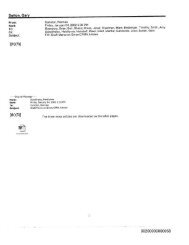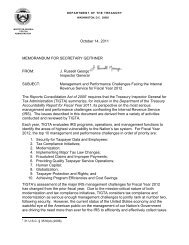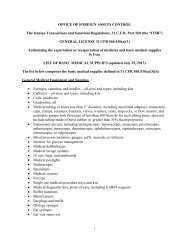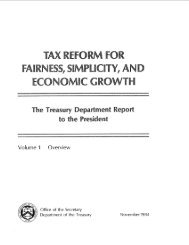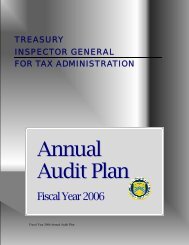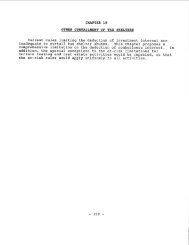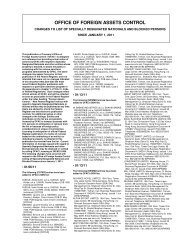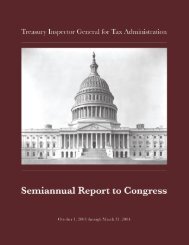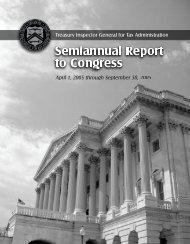Annual Audit Plan -- FY2005 - Department of the Treasury
Annual Audit Plan -- FY2005 - Department of the Treasury
Annual Audit Plan -- FY2005 - Department of the Treasury
You also want an ePaper? Increase the reach of your titles
YUMPU automatically turns print PDFs into web optimized ePapers that Google loves.
<strong>Treasury</strong> Inspector General for Tax Administration - Office <strong>of</strong> <strong>Audit</strong><br />
6. Is <strong>the</strong> IRS adequately protecting its employees, facilities, data, and<br />
systems?<br />
These questions are, by design, very broad, and answering <strong>the</strong>m could require work in<br />
various IRS divisions/functions by more than one Office <strong>of</strong> <strong>Audit</strong> business unit. For this<br />
reason, each Assistant Inspector General for <strong>Audit</strong> (AIGA) is taking <strong>the</strong> lead in<br />
coordinating <strong>the</strong> work needed to answer one <strong>of</strong> <strong>the</strong> questions. Fur<strong>the</strong>r, because no audit<br />
organization has <strong>the</strong> resources to focus on every issue all <strong>the</strong> time, <strong>the</strong> Office <strong>of</strong> <strong>Audit</strong><br />
will initially focus primarily on <strong>the</strong> first four questions.<br />
Identifying audits that will answer <strong>the</strong>se questions requires incorporating a risk<br />
assessment process that integrates pr<strong>of</strong>essional judgment into assessing <strong>the</strong> probability<br />
that adverse conditions or events may occur and applying risk factors to key auditable<br />
areas in <strong>the</strong> IRS. Some factors used in evaluating <strong>the</strong> risks associated with <strong>the</strong> IRS’<br />
auditable areas are: stakeholder concerns, impact <strong>of</strong> new programs and tax legislation,<br />
reliability <strong>of</strong> internal control systems, and past audit results. Input from TIGTA<br />
executives and top-level IRS management, current workload, and o<strong>the</strong>r factors are also<br />
considered before a final decision is made on which audits will be conducted.<br />
TIGTA’s listing <strong>of</strong> <strong>the</strong> major management challenges facing <strong>the</strong> IRS in FY 2005 is<br />
included as Appendix II. The IRS’ goals and objectives for <strong>the</strong> next five fiscal years are<br />
highlighted in Appendix III. Key initiatives <strong>of</strong> The President’s Management Agenda are<br />
included as Appendix IV.<br />
<strong>Plan</strong>ned FY 2005 audits have been mapped to <strong>the</strong> management challenges, <strong>the</strong> IRS’ goals<br />
and objectives, The President’s Management Agenda initiatives, and <strong>the</strong> strategic<br />
planning questions. The graphs in Appendices V, VI, VII, and VIII illustrate <strong>the</strong><br />
FY 2005 resources that will address <strong>the</strong> audits as <strong>the</strong>y correlate to each. Appendix IX<br />
shows <strong>the</strong> resources planned for statutory versus discretionary audits.<br />
Fiscal Year 2005 <strong>Annual</strong> <strong>Audit</strong> <strong>Plan</strong> Page 6



